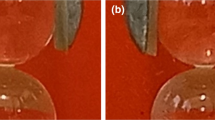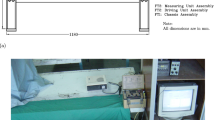Abstract
Fracture behaviour of adhesive joints under mixed mode loading is analysed by using the beam/adhesive-layer (b/a) model, in which, the adherends are beamlike and the adhesive is constrained to a thin flexible layer between the adherends. The adhesive layer deforms in peel (mode I), in shear (mode II) or in a combination of peel and shear (mixed mode). Macroscopically, the ends of the bonded part of the joints can be considered as crack tips. The energy release rate of a single-layer adhesive joint is then formulated as a function of the crack tip deformation and the mode-mixity is defined by the shear portion of the total energy release rate. The effects of transversal forces and the flexibility of the adhesive layer are included in the b/a-model, which can be applied to joints with short crack length as well as short bonding length. The commonly used end-loaded unsymmetric semi-infinite joints are examined and closed-form solutions are given. In comparison to the singular-field model in the context of linear elastic fracture mechanics, the b/a-model replaces the singularity at the crack tip with a stress concentration zone. It is shown that the b/a-model and the singular-field model yield fundamentally different mode-mixities for unsymmetric systems. The presented closed-form b/a-model solutions facilitates parametric studies of the influence of unbalance in loading, unsymmetry of the adherends, as well as the flexibility of the adhesive layer, on the mode mixity of an adhesive joint.
Similar content being viewed by others
References
Alfredsson KS (2004) Constitutive behaviour and fracture of adhesive layers. Thesis for the degree of doctor of philosophy. Chalmers University of Technology, Göteborg, Sweden
Andersson T and Stigh U (2004). The stress-elongation relation for an adhesive layer loaded in peel using equilibrium of energetic forces. Int J Solids Struct 41: 413–434
Bigwood DA and Crocombe AD (1989). Elastic analysis and engineering design formulae for bonded joints. Int J Adhesion Adhesives 9: 229–242
Cornell RW (1953). Determination of stresses in cemented lap joints. J Appl Mech 20(3): 355–364
Charalambides M, Kinloch AJ, Wang Y and Williams JG (1992). On the analysis of mixed-mode failure. Int J Frac 54: 269–291
Davidson BD, Hu H and Schapery RA (1995). An analytical crack-tip element for layered elastic structures. J Appl Mech 62: 294–305
Davidson BD, Fariello PF, Hudson RC, Sundararaman V (1997) Accuracy assessment of the singular-field-based mode-mix decomposition procedure for the prediction of delamination. In: Hooper SJ (ed) Thirteenth ASTM symposium on composite materials: testing and design. ASTM STP vol 1242. American society for Testing and Materials, pp 109–128
Davidson BD, Gharibian SJ and Yu L (2000). Evaluation of energy release rate-based approaches for predicting delamination growth in laminated composites. Int J Frac 105: 343–365
Davidson BD, Bialaszewski RD and Sainath SS (2006). A non-classical, energy release rate based approach for predicting delamination growth in graphite reinforced laminated polymeric composites. Compos Sci Technol 66(10): 1479–1496
Edlund U and Klarbring A (1990). Analysis of elastic and elastic-plastic adhesive joints using a mathematical programming approach. Comput Methods Appl Mech Eng 78: 19–47
Fernlund G and Spelt JK (1994). Mixed mode energy release rates for adhesively bonded beam specimens. J Compos Technol Res 16: 234–243
Goland M and Reissner E (1944). The stresses in cemented joints. J Appl Mech 66: A17–A27
Högberg JL (2004) Mechanical behaviour of single-layer adhesive joints. Thesis for the degree of licentiate of engineering. Chalmers University of Technology, Göteborg, Sweden
Högberg JL and Stigh U (2006). Specimen proposals for mixed mode testing of adhesive layers. Eng Frac Mech 73: 2541–2556
Hutchinson JW (2004) Private communication
Hutchinson JW and Suo Z (1990). Mixed mode cracking in layered materials. Adv Appl Mech 29: 63–191
Klarbring A (1991). Derivation of a model of adhesively bonded joints by the asymptotic expansion method. Int J Eng Sci 29: 493–512
Krenk S (1992). Energy release rate of symmetric adhesive joints. Eng Frac Mech 43: 549–559
Lai Y-H, Rakestraw MD and Dillard DA (1996). The cracked lap shear specimen revisited—a closed form solution. Int J Solids Struct 33: 1725–1743
Leffler K, Alfredsson KS and Stigh U (2007). Shear behaviour of adhesive layers. Int J Solids Struct 44: 530–545
Li S, Wang J and Thouless MD (2004). The effects of shear on delamination in layered materials. J Mech Phys Solids 52: 193–214
Olsson P and Stigh U (1989). On the determination of the constitutive properties of thin interphase layers—an exact inverse solution. Int J Frac 41: R71–R76
Paris AJ and Paris PC (1988). Instantaneous evaluation of J and C *.. Int J Fract 38(1): R19–R21
(2005). Mechanica wildfire 3.0. Parametric Technology Corporation, Needham, MA
Rice JR (1968). A path independent integral and the approximate analysis of strain concentration by notches and cracks. J Appl Mech 35: 379–386
Schapery RA and Davidson BD (1990). Prediction of energy release rate for mixed-mode delamination using classical plate theory. Appl Mech Rev 43(5): S281–S287
Schmidt P (2001) Analysis of adhesively bonded joints—an asymptotic approach. Linköping Studies in Science and Technology, Thesis No. 925, Linköping University, Linköping, Sweden
Suo Z and Hutchinson JW (1990). Interface crack between two elastic layers. Int J Frac 43: 1–18
Williams JG (1988). On the calculation of energy release rates for cracked laminates. Int J Frac 36: 101–119
Author information
Authors and Affiliations
Corresponding author
Rights and permissions
About this article
Cite this article
Alfredsson, K.S., Högberg, J.L. Energy release rate and mode-mixity of adhesive joint specimens. Int J Fract 144, 267–283 (2007). https://doi.org/10.1007/s10704-007-9099-9
Received:
Accepted:
Published:
Issue Date:
DOI: https://doi.org/10.1007/s10704-007-9099-9




